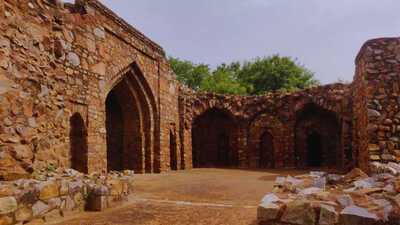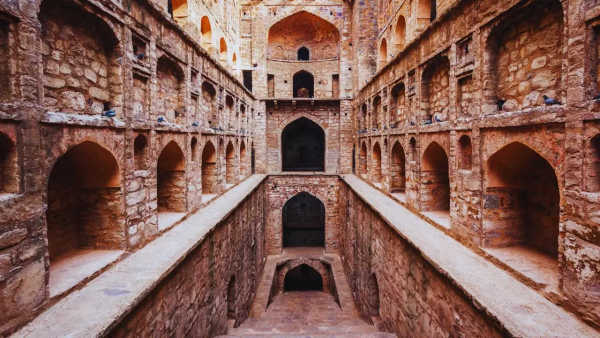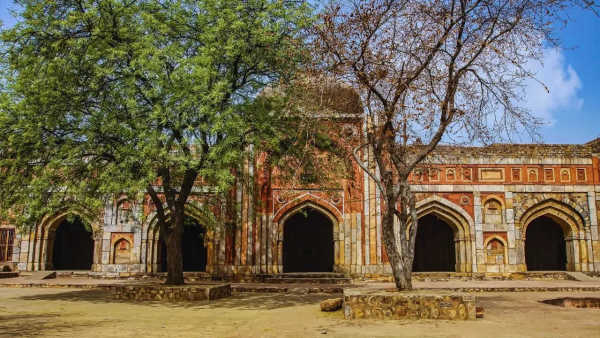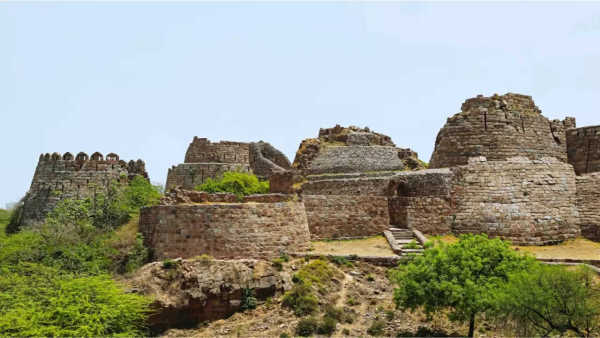Tourist attractions in Delhi that are surrounded by supernatural tales of djinns and spirits
ETimes November 25, 2025 03:39 AM
 Bhoot, djinns, folklores, late-night ghost stories, stories by the campfire…these are things one wants to stay away from but can’t.
Bhoot, djinns, folklores, late-night ghost stories, stories by the campfire…these are things one wants to stay away from but can’t.
Delhi is a city where centuries overlap effortlessly. Grand forts, Mughal-era tombs, forgotten stepwells, and sprawling ruins sit quietly between modern highways, glass towers, and the relentless, crowded streets. But beyond its celebrated monuments and textbook history lies another layer, the stories whispered by locals, passed down through generations, and tied to certain corners of the city. Some of these stories are fascinating, and some sound like they were taken from some “scary” movies that didn’t do too well. We, of course, are not complaining. Our search for all things fun, paranormal and clearly outrageous have brought us to Delhi’s pasts and secrets. Let’s dive deep into the world of grand architecture, supernatural legends, spirits that slap people and more.
djinns, supernatural beings mentioned in Islamic tradition. Locals say that the ruins, particularly the dark chambers and old cells beneath the Ashokan Pillar, are home to benevolent djinns who listen to prayers. Every Thursday, devotees of all backgrounds come to light candles, offer incense, paste letters on the walls, and tie threads while silently placing their wishes before these unseen listeners.
Khooni Darwaza: A gate shadowed by violent historyStanding near Delhi Gate on the Bahadur Shah Zafar Marg, Khooni Darwaza is an imposing Mughal-era gateway whose name translates to “The Bloody Gate.” The supernatural tales here are tied directly to its turbulent past. This gate witnessed multiple violent episodes across centuries. The most infamous occurred in 1857, when the sons and grandson of the last Mughal emperor, Bahadur Shah Zafar, were executed here by British officer Major William Hodson during the revolt. Locals say the spirits of the slain royal princes still linger around the site. Many believe the place holds a heavy, unsettling energy, especially after sundown.
 Agrasen ki Baoli: The stepwell of echoesTucked off the busy Hailey Road in Connaught Place stands Agrasen ki Baoli, one of Delhi’s most photographed monuments. This centuries-old stepwell is a masterpiece of step architecture with 108 symmetrical steps leading down to what was once a water reservoir. The site gained pop culture fame after the film
PK, but its supernatural stories date back long before Bollywood discovered it.
Agrasen ki Baoli: The stepwell of echoesTucked off the busy Hailey Road in Connaught Place stands Agrasen ki Baoli, one of Delhi’s most photographed monuments. This centuries-old stepwell is a masterpiece of step architecture with 108 symmetrical steps leading down to what was once a water reservoir. The site gained pop culture fame after the film
PK, but its supernatural stories date back long before Bollywood discovered it.
Locals believe Agrasen ki Baoli was once filled with dark, deep water that seemed to “call out” to visitors. Folklore suggests that the water mesmerised people, drawing them towards it. While no documented incidents exist, such stories became a part of Delhi’s oral tradition. Also, how can one ignore the slightly funny takes of how people sometimes get slapped by an unseen hand. That’s simply wild.
 Jamali Kamali Tomb and Mosque: Resting place of a Sufi poet and a legendLocated in the Mehrauli Archaeological Park, Jamali Kamali is one of the most architecturally beautiful yet folklore-heavy tomb complexes in Delhi. It houses the tomb of the Sufi poet Shaikh Jamali Kamboh and a mysterious figure known only as Kamali, whose identity remains debated by historians.
Jamali Kamali Tomb and Mosque: Resting place of a Sufi poet and a legendLocated in the Mehrauli Archaeological Park, Jamali Kamali is one of the most architecturally beautiful yet folklore-heavy tomb complexes in Delhi. It houses the tomb of the Sufi poet Shaikh Jamali Kamboh and a mysterious figure known only as Kamali, whose identity remains debated by historians.
Stories associated with this monument claim that
djinns inhabit its chambers and surrounding ruins. Visitors and guards have reported hearing unexplained sounds like whispers, footsteps, even voices, though no formal investigations support these claims. The monument lies within the famous Mehrauli Archaeological Park filled with dense trees, old walls, and deep silence.
Malcha Mahal: A palace of isolation and urban legendsPerhaps the most mysterious site on this list, Malcha Mahal sits in the Central Ridge near Chanakyapuri, hidden in plain sight within thick forest cover. Originally, it was built as a Tughlaq-era hunting lodge called Wilayat Mahal, it became globally known in the 20th century when a royal family from Awadh lived here in near-total isolation for decades.
Their reclusive life led to many sensationalised stories like reports of lights, shadows, and supernatural sightings in and around the building. The structure remains closed to the public due to safety concerns, but the surrounding Ridge forest is open for exploration. Travellers often include this area in heritage walks or forest trails to experience a different side of Delhi.
 Tughlaqabad Fort: A haunted legacy of a cursed SultanateSpread across vast rocky terrain, the 14th-century Tughlaqabad Fort is one of Delhi’s most monumental ruins. According to legend, the fort was cursed by Nizamuddin Auliya, the revered Sufi saint, during a dispute with Sultan Ghiyasuddin Tughlaq. The saint’s famous words,
“Ya rahe ujjar, ya base Gujjar,” are believed by many to have predicted the fort’s eventual abandonment. Over time, stories of spirits, strange sounds, and eerie sightings started to circulate among locals, especially because of the fort’s sheer size and isolated sections. Historically, Tughlaqabad Fort is one of Delhi’s most important architectural sites.
Tughlaqabad Fort: A haunted legacy of a cursed SultanateSpread across vast rocky terrain, the 14th-century Tughlaqabad Fort is one of Delhi’s most monumental ruins. According to legend, the fort was cursed by Nizamuddin Auliya, the revered Sufi saint, during a dispute with Sultan Ghiyasuddin Tughlaq. The saint’s famous words,
“Ya rahe ujjar, ya base Gujjar,” are believed by many to have predicted the fort’s eventual abandonment. Over time, stories of spirits, strange sounds, and eerie sightings started to circulate among locals, especially because of the fort’s sheer size and isolated sections. Historically, Tughlaqabad Fort is one of Delhi’s most important architectural sites.
 Bhoot, djinns, folklores, late-night ghost stories, stories by the campfire…these are things one wants to stay away from but can’t.
Bhoot, djinns, folklores, late-night ghost stories, stories by the campfire…these are things one wants to stay away from but can’t.
 Agrasen ki Baoli: The stepwell of echoesTucked off the busy Hailey Road in Connaught Place stands Agrasen ki Baoli, one of Delhi’s most photographed monuments. This centuries-old stepwell is a masterpiece of step architecture with 108 symmetrical steps leading down to what was once a water reservoir. The site gained pop culture fame after the film
PK, but its supernatural stories date back long before Bollywood discovered it.
Agrasen ki Baoli: The stepwell of echoesTucked off the busy Hailey Road in Connaught Place stands Agrasen ki Baoli, one of Delhi’s most photographed monuments. This centuries-old stepwell is a masterpiece of step architecture with 108 symmetrical steps leading down to what was once a water reservoir. The site gained pop culture fame after the film
PK, but its supernatural stories date back long before Bollywood discovered it.
 Jamali Kamali Tomb and Mosque: Resting place of a Sufi poet and a legendLocated in the Mehrauli Archaeological Park, Jamali Kamali is one of the most architecturally beautiful yet folklore-heavy tomb complexes in Delhi. It houses the tomb of the Sufi poet Shaikh Jamali Kamboh and a mysterious figure known only as Kamali, whose identity remains debated by historians.
Jamali Kamali Tomb and Mosque: Resting place of a Sufi poet and a legendLocated in the Mehrauli Archaeological Park, Jamali Kamali is one of the most architecturally beautiful yet folklore-heavy tomb complexes in Delhi. It houses the tomb of the Sufi poet Shaikh Jamali Kamboh and a mysterious figure known only as Kamali, whose identity remains debated by historians.
 Tughlaqabad Fort: A haunted legacy of a cursed SultanateSpread across vast rocky terrain, the 14th-century Tughlaqabad Fort is one of Delhi’s most monumental ruins. According to legend, the fort was cursed by Nizamuddin Auliya, the revered Sufi saint, during a dispute with Sultan Ghiyasuddin Tughlaq. The saint’s famous words,
“Ya rahe ujjar, ya base Gujjar,” are believed by many to have predicted the fort’s eventual abandonment. Over time, stories of spirits, strange sounds, and eerie sightings started to circulate among locals, especially because of the fort’s sheer size and isolated sections. Historically, Tughlaqabad Fort is one of Delhi’s most important architectural sites.
Tughlaqabad Fort: A haunted legacy of a cursed SultanateSpread across vast rocky terrain, the 14th-century Tughlaqabad Fort is one of Delhi’s most monumental ruins. According to legend, the fort was cursed by Nizamuddin Auliya, the revered Sufi saint, during a dispute with Sultan Ghiyasuddin Tughlaq. The saint’s famous words,
“Ya rahe ujjar, ya base Gujjar,” are believed by many to have predicted the fort’s eventual abandonment. Over time, stories of spirits, strange sounds, and eerie sightings started to circulate among locals, especially because of the fort’s sheer size and isolated sections. Historically, Tughlaqabad Fort is one of Delhi’s most important architectural sites.